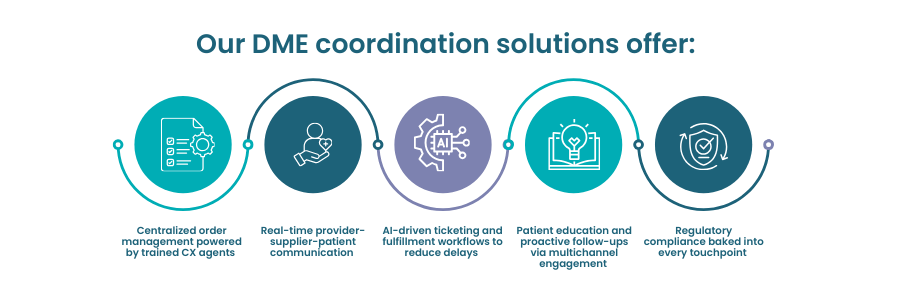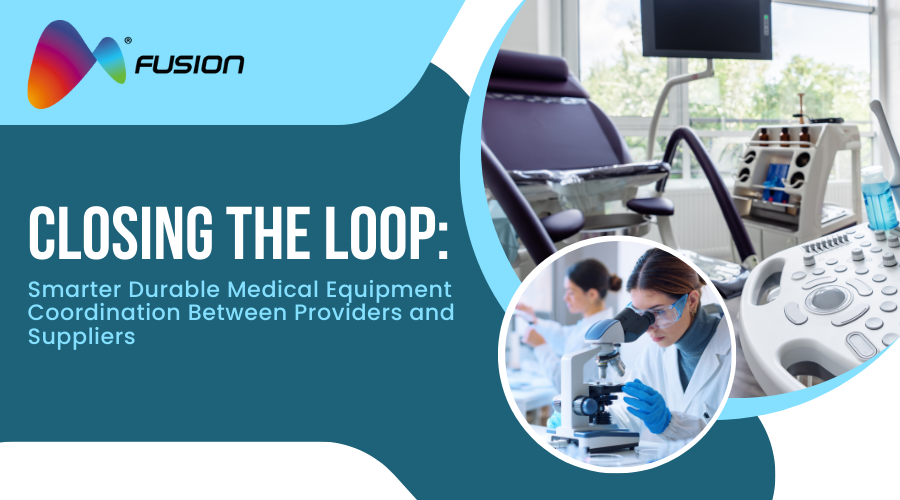In the fast-evolving world of healthcare, speed, precision, and seamless collaboration are not just “nice-to-haves”—they are make-or-break essentials. Yet when it comes to durable medical equipment (DME) coordination, many healthcare providers and suppliers are still dancing to the rhythm of disconnected systems, fax machines (yes, really), and long email chains that rival epic novels. It’s time to close the loop.
Durable Medical Equipment coordination—the smooth handoff between provider prescriptions and supplier fulfillment—shouldn’t feel like a game of broken telephone. With the right collaboration models in place, healthcare organizations can dramatically improve operational efficiency, reduce errors, and, most importantly, enhance patient care.
Let’s explore how a smarter, patient-centered approach to DME coordination can make life easier for providers, suppliers, and the patients they serve—and where Fusion CX fits in to make that transformation not just possible, but scalable.
Why Durable Medical Equipment Coordination Is So Challenging
DME includes everything from wheelchairs and oxygen tanks to hospital beds and diabetic monitors—critical tools in the journey of recovery and independence. But getting these devices from prescription to front porch can often feel like navigating a maze blindfolded.
Common issues include:
- Manual processes and outdated systems that delay order processing
- Incomplete documentation that leads to rejections or rework
- Lack of visibility into order status and delivery timelines
- Poor communication between providers and suppliers
- Patient frustration when equipment arrives late or not at all
In a healthcare system that’s increasingly driven by outcomes and value-based care, these pain points can quickly snowball into high costs, poor compliance, and diminished patient trust.
1. Shared Digital Platforms: The Hub of DME Harmony
The first step in building a better DME ecosystem is embracing digital tools that create real-time visibility for both providers and suppliers.
Imagine this: A provider submits a DME request into an integrated platform, the supplier sees it instantly, checks real-time inventory, and confirms delivery timelines without a single phone call or email volley. (Your fax machine just sighed in relief.)
Shared platforms should support:
- Order placement and tracking
- Inventory transparency
- Document uploads and secure communication
This kind of centralized system reduces confusion, speeds up fulfillment, and helps everyone stay on the same page—without needing a thousand CC’d emails.
2. Collaborative Workflows: When Providers and Suppliers Actually Talk
A major reason for DME coordination friction is the simple fact that providers and suppliers don’t always work from the same playbook. Different expectations, varied documentation standards, and inconsistent processes lead to rework and finger-pointing.
Collaborative workflows solve that by:
- Aligning on documentation standards and timelines
- Embedding insurance pre-authorization into the process
- Using shared performance metrics to drive accountability
Regular huddles, workflow audits, and even “coffee & compliance” sessions can help break down silos. If suppliers and providers treated each other like co-pilots instead of passing ships in the night, patients wouldn’t be left waiting on the tarmac for their much-needed equipment.
3. Transparency Through Data Sharing
Trust in healthcare coordination is built on transparency—and that requires data. Whether it’s sharing real-time inventory levels, expected delivery windows, or even equipment maintenance schedules, the more everyone knows, the better the outcomes.
Data-sharing enables:
- Better patient communication (“Your wheelchair will arrive Thursday at 2 PM” beats “We’ll call you back.”)
- Proactive maintenance and replacement planning
- Clarity on costs so patients can avoid financial surprises
Suppliers sharing delivery data with providers not only builds trust, it lets healthcare staff focus on care instead of chasing couriers.
4. Don’t Forget the Human Touch
While tech is essential, human support is the glue that keeps it all together. Dedicated care coordinators, relationship managers, or liaisons can be the difference between a smooth order and a missed delivery window.
They provide:
- Single points of contact for issue resolution
- Proactive status updates
- Personalized member outreach and education
In fact, having a human on the line builds confidence among patients who might be overwhelmed or anxious about their equipment.
5. Patient-Centric Collaboration: The North Star
All this collaboration, coordination, and technology ultimately exists for one reason: to support better outcomes for patients.
When providers, suppliers, and partners like Fusion CX work together, patients benefit from:
- Timely equipment delivery
- Better adherence to treatment plans
- Reduced hospital readmissions
- Higher satisfaction and trust in their care journey
And from a business perspective, better DME support translates into reduced operational overhead, stronger provider-supplier relationships, and compliance peace of mind.
Enter Fusion CX: Coordinating DME with Intelligence and Empathy
Here’s where we roll up our sleeves.
At Fusion CX, we specialize in closing coordination gaps between healthcare providers, payers, and DME suppliers through scalable, tech-enabled, and empathy-driven solutions. With over 35 years of healthcare experience across 15 countries, we help our clients turn DME support from a liability into a strategic advantage.
 We believe DME support should be less “hurry up and wait” and more “click, confirm, deliver.” Our contact centers are built to handle scale, seasonality, and sensitivity—because behind every equipment request is a person waiting to heal, move, or breathe better.
We believe DME support should be less “hurry up and wait” and more “click, confirm, deliver.” Our contact centers are built to handle scale, seasonality, and sensitivity—because behind every equipment request is a person waiting to heal, move, or breathe better.
Also, we’ve fully retired the office fax machine. (May it rest in paper-filled peace.)
The Takeaway: No More Broken Loops
Durable Medical Equipment coordination doesn’t have to be a slow, fragmented process. With digital platforms, collaborative workflows, transparent data sharing, and a patient-first mindset, healthcare organizations can finally close the loop.
And if you’re looking for a partner who can bring the tech, the talent, and just a touch of humor to the process—Fusion CX is ready to help you transform DME support into something that works for everyone.

